Climate change shrinking reindeer pastures: Nina

Climate change and overgrazing are causing a growing shortage of the lichen Norway’s reindeers depend on for food, a new report from the Norwegian Institute for Nature Research (Nina) has warned.
According to the report, the Finnmark plateau, Norway’s most important reindeer grazing area, risks returning to the crisis conditions seen in the late 1990s unless herders take urgent action to reduce numbers.
“You could say we're heading back to the situation that there was at the end of the 1990s, when lichen was greatly reduced over large parts of the plateau, especially in the northern area,” Hans Tømmervik, who led the study, told NRK.
According to Tømmervik, warmer temperatures have extended forest cover both further north and to higher altitudes, reducing the area covered by lichen.
At the same time, increased summer rainfall is helping grass, heather and bushes to compete with the reindeers' main food.
Reindeer are unique among mammals in their ability to eat lichen, using a special enzyme called lichenase. They also eat willow and birch leaves, and some grasses.
Nina’s report, which was based on ground monitoring of pasture areas in the winter of 2013, is supported by a second report by the Northern Research Institute, which used satellite data to examine grazing condition on the plateau.
From the late 1990s until 2005, lichen cover grew on Finnmarksvidda but an increase in reindeer numbers since then has increased grazing pressure.
According to the report, all but one of the 30 areas studied had seen a reduction in lichen biomass between 2010 and 2013.
“This implies that the reindeer has to seek over large areas every day to cover their nutrient requirements,” the report read.
As a result, the report warned that the lichen itself may struggle to recover.
“When lichen biomass is as scarce as is the current situation in large parts of southern Finnmark, even relatively low reindeer densities impede increases in lichen biomass over time.”
Tømmervik told NRK that he was confident that herders would be responsible and shrink their herds to more sustainable sizes, allowing grazing conditions to improve.
“Reindeer owners are trying to reduce the number of reindeer, so we expect that there will be an improvement in some areas. I’m quite positive about the situation, and hopefully we will not return to the situation we had in the 1990s,” he said.
Comments
See Also
According to the report, the Finnmark plateau, Norway’s most important reindeer grazing area, risks returning to the crisis conditions seen in the late 1990s unless herders take urgent action to reduce numbers.
“You could say we're heading back to the situation that there was at the end of the 1990s, when lichen was greatly reduced over large parts of the plateau, especially in the northern area,” Hans Tømmervik, who led the study, told NRK.
According to Tømmervik, warmer temperatures have extended forest cover both further north and to higher altitudes, reducing the area covered by lichen.
At the same time, increased summer rainfall is helping grass, heather and bushes to compete with the reindeers' main food.
Reindeer are unique among mammals in their ability to eat lichen, using a special enzyme called lichenase. They also eat willow and birch leaves, and some grasses.
Nina’s report, which was based on ground monitoring of pasture areas in the winter of 2013, is supported by a second report by the Northern Research Institute, which used satellite data to examine grazing condition on the plateau.
From the late 1990s until 2005, lichen cover grew on Finnmarksvidda but an increase in reindeer numbers since then has increased grazing pressure.
According to the report, all but one of the 30 areas studied had seen a reduction in lichen biomass between 2010 and 2013.
“This implies that the reindeer has to seek over large areas every day to cover their nutrient requirements,” the report read.
As a result, the report warned that the lichen itself may struggle to recover.
“When lichen biomass is as scarce as is the current situation in large parts of southern Finnmark, even relatively low reindeer densities impede increases in lichen biomass over time.”
Tømmervik told NRK that he was confident that herders would be responsible and shrink their herds to more sustainable sizes, allowing grazing conditions to improve.
“Reindeer owners are trying to reduce the number of reindeer, so we expect that there will be an improvement in some areas. I’m quite positive about the situation, and hopefully we will not return to the situation we had in the 1990s,” he said.
Join the conversation in our comments section below. Share your own views and experience and if you have a question or suggestion for our journalists then email us at [email protected].
Please keep comments civil, constructive and on topic – and make sure to read our terms of use before getting involved.
Please log in here to leave a comment.